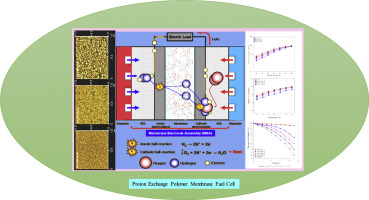International Journal of Hydrogen Energy ( IF 8.1 ) Pub Date : 2019-01-21 , DOI: 10.1016/j.ijhydene.2018.12.132
Sabuj Chandra Sutradhar , Faiz Ahmed , Taewook Ryu , Jin Lei , Sujin Yoon , Inhwan Choi , Daeho Kim , Yongcheng Jin , Whangi Kim

|
The major challenges experienced by the researchers till now are to synthesis the chemically and mechanically stable proton exchange membranes. However, Ni catalyzed CC coupling polymerization together with condensation reaction assist to get the high molecular weight polymer membranes as well as thermally and chemically stable PEMs. In this study, bisphenol A-based sulfonated poly (arylene)s copolymers (bis A-SPAs) have been successfully synthesized by the carbon-carbon coupling polymerization using Ni (0) catalyst from sulfonated 1,4-dibenzoyl-2,5-dichlorobenzene (SDBDCB) monomer and subsequently condensation reaction with bisphenol A. The (bis A-SPAs) membranes were flexible in nature and attained high molecular weight. The synthesized (bis A-SPAs) membranes exhibited water uptake from 7.42 to 56.4%, ion exchange capacity ranging from 0.73 to 1.67 meq/g, and proton conductivity from 48.8 to 96.4 mS/cm (at 90 °C) with maximum power density of 0.48–0.60 W/cm2. Membrane with high-sulfonated degree (bis A-SPAs-50) showed almost analogous conductivity (96.4 mS/cm) to Nafion® 117 membrane (98.92 mS/cm) at 90 °C and 90% humidity. The synthesized sulfonated polymer membranes displayed well phase separation that increased the proton conductivity. The TGA and Fenton's test results confirmed that the synthesized membranes possessed admirable thermal stability and mechanical stability. Therefore, the new synthesized (bis A-SPAs) membranes have the promising suitable properties as a proton exchange membrane in the fuel cell applications.
中文翻译:

PEMFC的Ni(II)催化二苯甲酰基-二氯苯双酚A基碳-碳偶联聚亚芳基
迄今为止,研究人员面临的主要挑战是合成化学和机械稳定的质子交换膜。但是,镍催化了碳C偶合聚合与缩合反应有助于获得高分子量聚合物膜以及热和化学稳定的PEM。在这项研究中,已经成功地使用Ni(0)催化剂通过碳-碳偶联聚合从磺化的1,4-二苯甲酰基-2,5-碳双键聚合成功地合成了双酚A基磺化的聚(亚芳基)共聚物(bis A-SPA)。二氯苯(SDBDCB)单体,然后与双酚A缩合反应。(bis A-SPAs)膜本质上具有柔性,并具有高分子量。合成(bis A-SPAs)膜的吸水率为7.42%至56.4%,离子交换容量为0.73至1.67 meq / g,质子电导率为48.8至96.4 mS / cm(在90°C下),具有最大功率密度0.48–0.60 W / cm 2。膜具有高磺化度(双A-SPAS-50)显示出几乎类似的电导率(96.4毫秒/厘米)与Nafion ®在90℃和90%湿度117膜(98.92毫秒/厘米)。合成的磺化聚合物膜表现出良好的相分离,从而增加了质子传导性。TGA和Fenton的测试结果证实合成的膜具有令人赞叹的热稳定性和机械稳定性。因此,在燃料电池应用中,新合成的(bis A-SPAs)膜具有作为质子交换膜的有前途的合适特性。

































 京公网安备 11010802027423号
京公网安备 11010802027423号